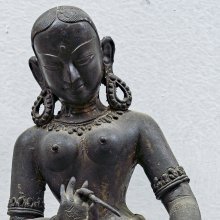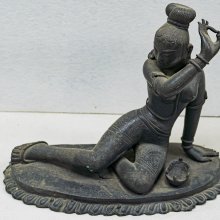Padmapitha, Padma-pitha, Padmapīṭha: 5 definitions
Introduction:
Padmapitha means something in Hinduism, Sanskrit, the history of ancient India. If you want to know the exact meaning, history, etymology or English translation of this term then check out the descriptions on this page. Add your comment or reference to a book if you want to contribute to this summary article.
Images (photo gallery)
In Hinduism
Shilpashastra (iconography)
Source: Google Books: The Book of Hindu Imagery: Gods, Manifestations and Their MeaningPadmapitha—Lotus pedestal; also known as padmasana and identiefied by the lotus leaves around the feet. The lotus is the symbol of a mother’s lap, amongst other things. All of life originates from this, including the life of the gods. That is why padmapitha is one of the most highly valued pedestals.
Source: academia.edu: Dvādaśa-mūrti in Tamil Tradition (iconography)Padmapīṭha (पद्मपीठ) refers to a particular type of colour or mien, according to the Śrītattvanidhi (verse 2.19-42) citing the Pāñcarātrāgama-Kriyapāda.—Madhusūdana’s Mien is the red-lotus and brilliant and padmapīṭha. According to the Caturviṃśatimūrtilakṣaṇa, The Pāñcarātra tradition (describing Keśava) got a stronghold over the Vaiṣṇava tradition by about the fourth century CE, e.g. the Ahirbhūdhnya-saṃhitā and so its impact on the Tamil Paripāṭal and hymns of the Āḻvārs is quite natural.

Shilpashastra (शिल्पशास्त्र, śilpaśāstra) represents the ancient Indian science (shastra) of creative arts (shilpa) such as sculpture, iconography and painting. Closely related to Vastushastra (architecture), they often share the same literature.
Vastushastra (architecture)
Source: OpenEdition books: Architectural terms contained in Ajitāgama and RauravāgamaPadmapīṭha (पद्मपीठ) refers to “- 1. n. of a type of pedestal §§ 3.7, 9, 15; 5. 3, 4, 17 - 2. n. of a type of substitute altar (Aj) § 5.13.”.—(For paragraphs cf. Les enseignements architecturaux de l'Ajitāgama et du Rauravāgama by Bruno Dagens)

Vastushastra (वास्तुशास्त्र, vāstuśāstra) refers to the ancient Indian science (shastra) of architecture (vastu), dealing with topics such architecture, sculpture, town-building, fort building and various other constructions. Vastu also deals with the philosophy of the architectural relation with the cosmic universe.
India history and geography
Source: Cologne Digital Sanskrit Dictionaries: Indian Epigraphical GlossaryPadma-pīṭha.—(SII 2), a lotus-pedestal. Note: padma-pīṭha is defined in the “Indian epigraphical glossary” as it can be found on ancient inscriptions commonly written in Sanskrit, Prakrit or Dravidian languages.

The history of India traces the identification of countries, villages, towns and other regions of India, as well as mythology, zoology, royal dynasties, rulers, tribes, local festivities and traditions and regional languages. Ancient India enjoyed religious freedom and encourages the path of Dharma, a concept common to Buddhism, Hinduism, and Jainism.
Languages of India and abroad
Kannada-English dictionary
Source: Alar: Kannada-English corpusPadmapīṭha (ಪದ್ಮಪೀಠ):—
1) [noun] a fully-blown lotus flower, as a seat (of a deity).
2) [noun] a seat in the form of a lotus flower.
Kannada is a Dravidian language (as opposed to the Indo-European language family) mainly spoken in the southwestern region of India.
See also (Relevant definitions)
Partial matches: Padma, Pitha, Pita.
Full-text (+1): Padmasana, Madhusudana, Shivottama, Kirita, Ananta, Devadeva, Kapalisha, Bhavodbhava, Nilalohita, Vijaya, Shankara, Shrikantha, Asana, Bhima, Mahadeva, Ekapada-Trimurti, Rudra, Murtyashtaka, Gada, Shiva.
Relevant text
Search found 5 books and stories containing Padmapitha, Padma-pitha, Padmapīṭha, Padma-pīṭha; (plurals include: Padmapithas, pithas, Padmapīṭhas, pīṭhas). You can also click to the full overview containing English textual excerpts. Below are direct links for the most relevant articles:
Temples in and around Madurantakam (by B. Mekala)
Kodandarama or Kothandarama Perumal Temple—Madurantakam < [Chapter 4 - Prominent Temples in Madurantakam Taluk]
Atcheeswarar Temple at Acharapakkam < [Chapter 4 - Prominent Temples in Madurantakam Taluk]
Sri Venkateswarar Temple < [Chapter 4 - Prominent Temples in Madurantakam Taluk]
Jain Remains of Ancient Bengal (by Shubha Majumder)
Miniature Tīrthaṅkara and Planatary Deities type of Candraprabha < [Chapter 6 - Iconographic Study of Jaina Sculptural Remains]
Early Chola Temples (by S. R. Balasubrahmanyam)
Bronze, group 1: Late Pallava and Early Chola—Age of Vijayalaya (a.d. 785-871) < [Chapter XI - Sculpture]
Bronze, group 3: Age of Parantaka I (a.d. 907 - 950) < [Chapter XI - Sculpture]
Manasara (English translation) (by Prasanna Kumar Acharya)
The Religion and Philosophy of Tevaram (Thevaram) (by M. A. Dorai Rangaswamy)
Chapter 1.3 - Umabhaga-murti (depiction of the Mother Goddess) < [Volume 2 - Nampi Arurar and Mythology]
Related products


